Comprehensive Report: Inclusive Practice in Education and Frameworks
VerifiedAdded on 2020/11/12
|20
|4724
|162
Report
AI Summary
This report provides a comprehensive overview of inclusive practices in education, addressing various aspects critical to fostering an inclusive learning environment. It begins by defining inclusive practice and identifying factors influencing inclusive teaching and learning, such as resource availability, societal acceptance, and cognitive abilities. The report then delves into the impact of the learning environment and cognitive ability, emphasizing the need for emotional, respectful, and physically comfortable spaces. Furthermore, it explores the influence of organizational policies and frameworks on inclusive education, highlighting the importance of awareness, access, and systematic approaches. The report also provides strategies to maintain an inclusive culture, evaluates strengths, and outlines a continuous development plan to ensure the needs of all students are met. The report underscores the importance of skilled teachers, financial considerations, and the attitudes of disabled children in achieving inclusive goals.
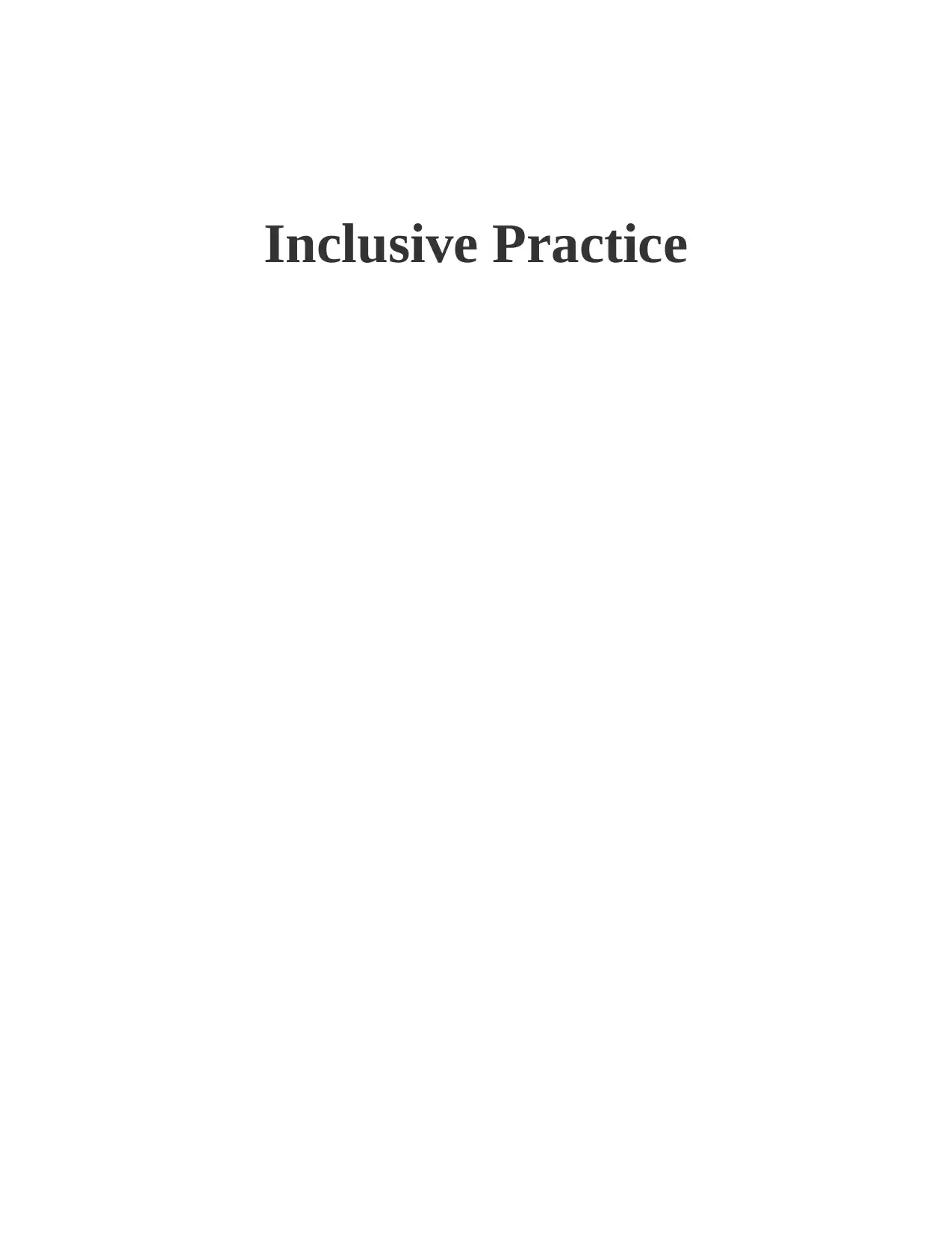
Inclusive Practice
Paraphrase This Document
Need a fresh take? Get an instant paraphrase of this document with our AI Paraphraser
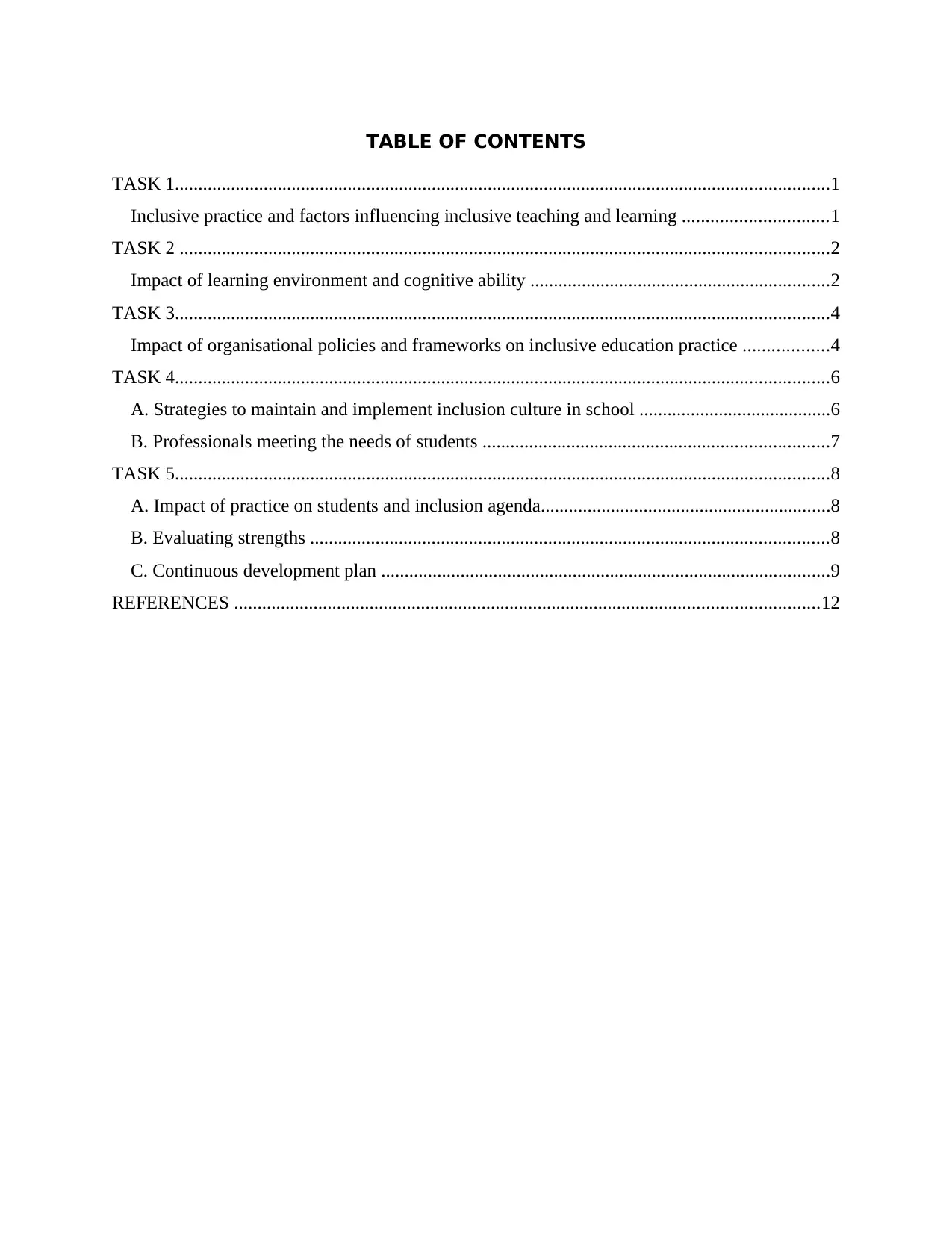
TABLE OF CONTENTS
TASK 1............................................................................................................................................1
Inclusive practice and factors influencing inclusive teaching and learning ...............................1
TASK 2 ...........................................................................................................................................2
Impact of learning environment and cognitive ability ................................................................2
TASK 3............................................................................................................................................4
Impact of organisational policies and frameworks on inclusive education practice ..................4
TASK 4............................................................................................................................................6
A. Strategies to maintain and implement inclusion culture in school .........................................6
B. Professionals meeting the needs of students ..........................................................................7
TASK 5............................................................................................................................................8
A. Impact of practice on students and inclusion agenda..............................................................8
B. Evaluating strengths ...............................................................................................................8
C. Continuous development plan ................................................................................................9
REFERENCES .............................................................................................................................12
TASK 1............................................................................................................................................1
Inclusive practice and factors influencing inclusive teaching and learning ...............................1
TASK 2 ...........................................................................................................................................2
Impact of learning environment and cognitive ability ................................................................2
TASK 3............................................................................................................................................4
Impact of organisational policies and frameworks on inclusive education practice ..................4
TASK 4............................................................................................................................................6
A. Strategies to maintain and implement inclusion culture in school .........................................6
B. Professionals meeting the needs of students ..........................................................................7
TASK 5............................................................................................................................................8
A. Impact of practice on students and inclusion agenda..............................................................8
B. Evaluating strengths ...............................................................................................................8
C. Continuous development plan ................................................................................................9
REFERENCES .............................................................................................................................12
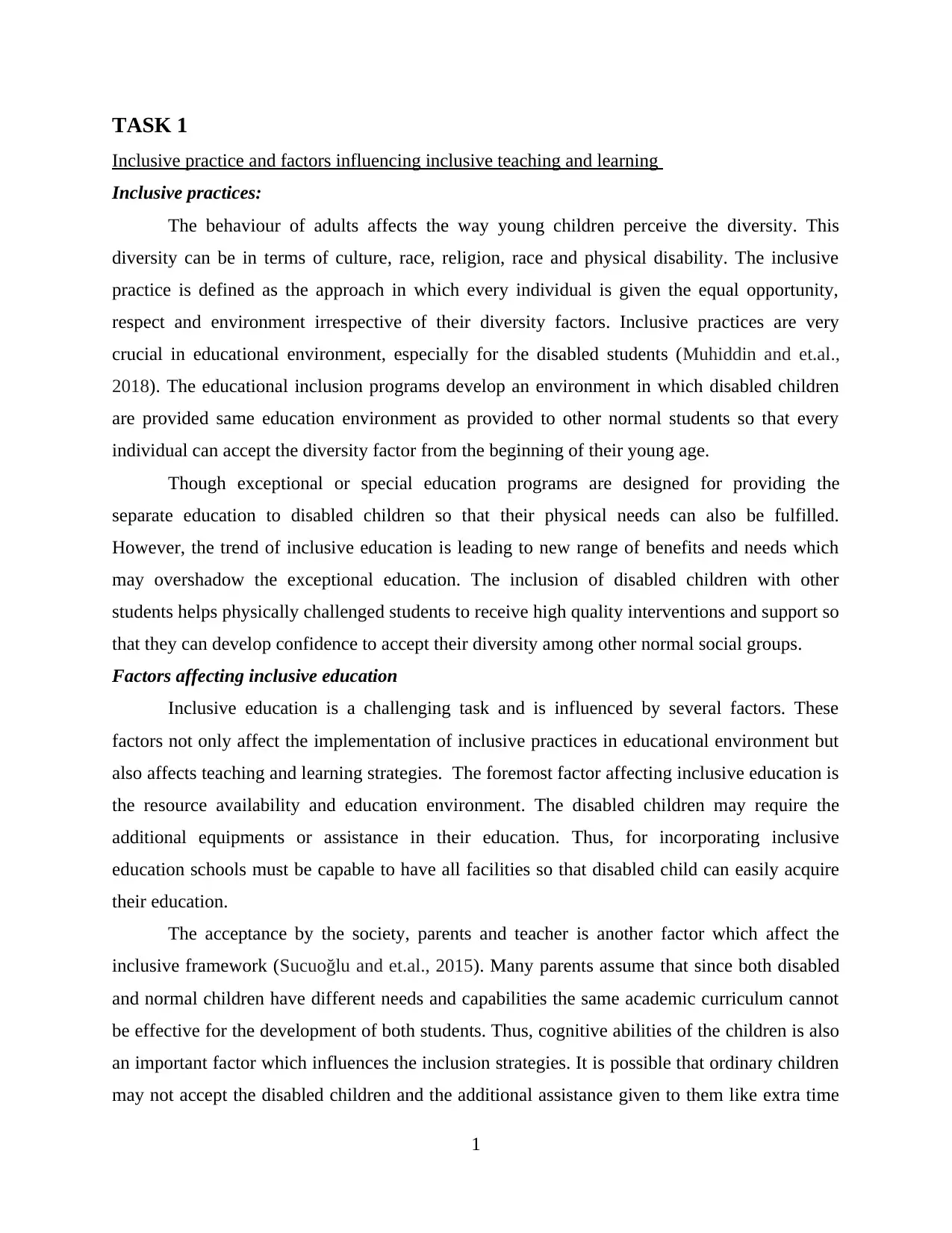
TASK 1
Inclusive practice and factors influencing inclusive teaching and learning
Inclusive practices:
The behaviour of adults affects the way young children perceive the diversity. This
diversity can be in terms of culture, race, religion, race and physical disability. The inclusive
practice is defined as the approach in which every individual is given the equal opportunity,
respect and environment irrespective of their diversity factors. Inclusive practices are very
crucial in educational environment, especially for the disabled students (Muhiddin and et.al.,
2018). The educational inclusion programs develop an environment in which disabled children
are provided same education environment as provided to other normal students so that every
individual can accept the diversity factor from the beginning of their young age.
Though exceptional or special education programs are designed for providing the
separate education to disabled children so that their physical needs can also be fulfilled.
However, the trend of inclusive education is leading to new range of benefits and needs which
may overshadow the exceptional education. The inclusion of disabled children with other
students helps physically challenged students to receive high quality interventions and support so
that they can develop confidence to accept their diversity among other normal social groups.
Factors affecting inclusive education
Inclusive education is a challenging task and is influenced by several factors. These
factors not only affect the implementation of inclusive practices in educational environment but
also affects teaching and learning strategies. The foremost factor affecting inclusive education is
the resource availability and education environment. The disabled children may require the
additional equipments or assistance in their education. Thus, for incorporating inclusive
education schools must be capable to have all facilities so that disabled child can easily acquire
their education.
The acceptance by the society, parents and teacher is another factor which affect the
inclusive framework (Sucuoğlu and et.al., 2015). Many parents assume that since both disabled
and normal children have different needs and capabilities the same academic curriculum cannot
be effective for the development of both students. Thus, cognitive abilities of the children is also
an important factor which influences the inclusion strategies. It is possible that ordinary children
may not accept the disabled children and the additional assistance given to them like extra time
1
Inclusive practice and factors influencing inclusive teaching and learning
Inclusive practices:
The behaviour of adults affects the way young children perceive the diversity. This
diversity can be in terms of culture, race, religion, race and physical disability. The inclusive
practice is defined as the approach in which every individual is given the equal opportunity,
respect and environment irrespective of their diversity factors. Inclusive practices are very
crucial in educational environment, especially for the disabled students (Muhiddin and et.al.,
2018). The educational inclusion programs develop an environment in which disabled children
are provided same education environment as provided to other normal students so that every
individual can accept the diversity factor from the beginning of their young age.
Though exceptional or special education programs are designed for providing the
separate education to disabled children so that their physical needs can also be fulfilled.
However, the trend of inclusive education is leading to new range of benefits and needs which
may overshadow the exceptional education. The inclusion of disabled children with other
students helps physically challenged students to receive high quality interventions and support so
that they can develop confidence to accept their diversity among other normal social groups.
Factors affecting inclusive education
Inclusive education is a challenging task and is influenced by several factors. These
factors not only affect the implementation of inclusive practices in educational environment but
also affects teaching and learning strategies. The foremost factor affecting inclusive education is
the resource availability and education environment. The disabled children may require the
additional equipments or assistance in their education. Thus, for incorporating inclusive
education schools must be capable to have all facilities so that disabled child can easily acquire
their education.
The acceptance by the society, parents and teacher is another factor which affect the
inclusive framework (Sucuoğlu and et.al., 2015). Many parents assume that since both disabled
and normal children have different needs and capabilities the same academic curriculum cannot
be effective for the development of both students. Thus, cognitive abilities of the children is also
an important factor which influences the inclusion strategies. It is possible that ordinary children
may not accept the disabled children and the additional assistance given to them like extra time
1
⊘ This is a preview!⊘
Do you want full access?
Subscribe today to unlock all pages.

Trusted by 1+ million students worldwide
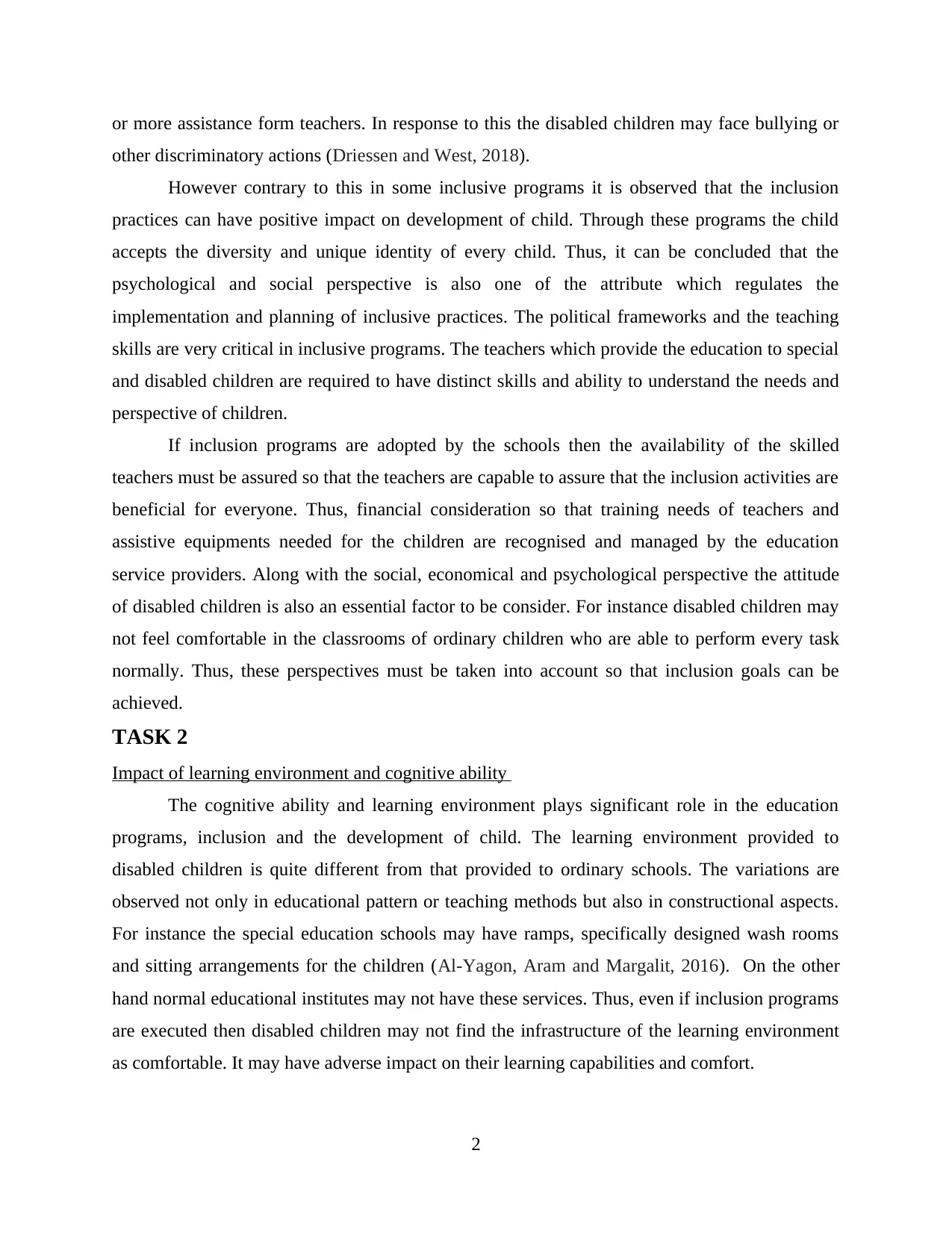
or more assistance form teachers. In response to this the disabled children may face bullying or
other discriminatory actions (Driessen and West, 2018).
However contrary to this in some inclusive programs it is observed that the inclusion
practices can have positive impact on development of child. Through these programs the child
accepts the diversity and unique identity of every child. Thus, it can be concluded that the
psychological and social perspective is also one of the attribute which regulates the
implementation and planning of inclusive practices. The political frameworks and the teaching
skills are very critical in inclusive programs. The teachers which provide the education to special
and disabled children are required to have distinct skills and ability to understand the needs and
perspective of children.
If inclusion programs are adopted by the schools then the availability of the skilled
teachers must be assured so that the teachers are capable to assure that the inclusion activities are
beneficial for everyone. Thus, financial consideration so that training needs of teachers and
assistive equipments needed for the children are recognised and managed by the education
service providers. Along with the social, economical and psychological perspective the attitude
of disabled children is also an essential factor to be consider. For instance disabled children may
not feel comfortable in the classrooms of ordinary children who are able to perform every task
normally. Thus, these perspectives must be taken into account so that inclusion goals can be
achieved.
TASK 2
Impact of learning environment and cognitive ability
The cognitive ability and learning environment plays significant role in the education
programs, inclusion and the development of child. The learning environment provided to
disabled children is quite different from that provided to ordinary schools. The variations are
observed not only in educational pattern or teaching methods but also in constructional aspects.
For instance the special education schools may have ramps, specifically designed wash rooms
and sitting arrangements for the children (Al-Yagon, Aram and Margalit, 2016). On the other
hand normal educational institutes may not have these services. Thus, even if inclusion programs
are executed then disabled children may not find the infrastructure of the learning environment
as comfortable. It may have adverse impact on their learning capabilities and comfort.
2
other discriminatory actions (Driessen and West, 2018).
However contrary to this in some inclusive programs it is observed that the inclusion
practices can have positive impact on development of child. Through these programs the child
accepts the diversity and unique identity of every child. Thus, it can be concluded that the
psychological and social perspective is also one of the attribute which regulates the
implementation and planning of inclusive practices. The political frameworks and the teaching
skills are very critical in inclusive programs. The teachers which provide the education to special
and disabled children are required to have distinct skills and ability to understand the needs and
perspective of children.
If inclusion programs are adopted by the schools then the availability of the skilled
teachers must be assured so that the teachers are capable to assure that the inclusion activities are
beneficial for everyone. Thus, financial consideration so that training needs of teachers and
assistive equipments needed for the children are recognised and managed by the education
service providers. Along with the social, economical and psychological perspective the attitude
of disabled children is also an essential factor to be consider. For instance disabled children may
not feel comfortable in the classrooms of ordinary children who are able to perform every task
normally. Thus, these perspectives must be taken into account so that inclusion goals can be
achieved.
TASK 2
Impact of learning environment and cognitive ability
The cognitive ability and learning environment plays significant role in the education
programs, inclusion and the development of child. The learning environment provided to
disabled children is quite different from that provided to ordinary schools. The variations are
observed not only in educational pattern or teaching methods but also in constructional aspects.
For instance the special education schools may have ramps, specifically designed wash rooms
and sitting arrangements for the children (Al-Yagon, Aram and Margalit, 2016). On the other
hand normal educational institutes may not have these services. Thus, even if inclusion programs
are executed then disabled children may not find the infrastructure of the learning environment
as comfortable. It may have adverse impact on their learning capabilities and comfort.
2
Paraphrase This Document
Need a fresh take? Get an instant paraphrase of this document with our AI Paraphraser
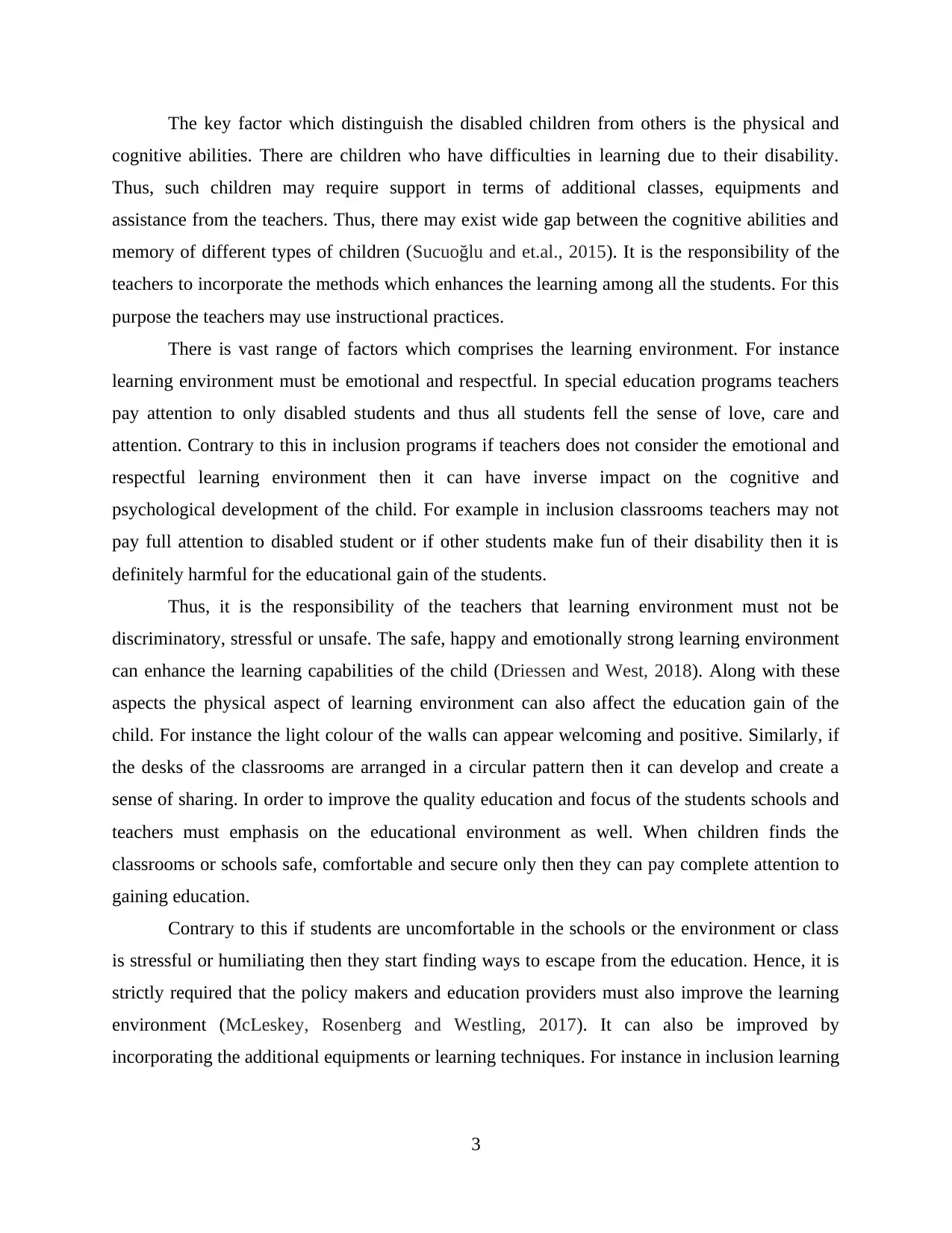
The key factor which distinguish the disabled children from others is the physical and
cognitive abilities. There are children who have difficulties in learning due to their disability.
Thus, such children may require support in terms of additional classes, equipments and
assistance from the teachers. Thus, there may exist wide gap between the cognitive abilities and
memory of different types of children (Sucuoğlu and et.al., 2015). It is the responsibility of the
teachers to incorporate the methods which enhances the learning among all the students. For this
purpose the teachers may use instructional practices.
There is vast range of factors which comprises the learning environment. For instance
learning environment must be emotional and respectful. In special education programs teachers
pay attention to only disabled students and thus all students fell the sense of love, care and
attention. Contrary to this in inclusion programs if teachers does not consider the emotional and
respectful learning environment then it can have inverse impact on the cognitive and
psychological development of the child. For example in inclusion classrooms teachers may not
pay full attention to disabled student or if other students make fun of their disability then it is
definitely harmful for the educational gain of the students.
Thus, it is the responsibility of the teachers that learning environment must not be
discriminatory, stressful or unsafe. The safe, happy and emotionally strong learning environment
can enhance the learning capabilities of the child (Driessen and West, 2018). Along with these
aspects the physical aspect of learning environment can also affect the education gain of the
child. For instance the light colour of the walls can appear welcoming and positive. Similarly, if
the desks of the classrooms are arranged in a circular pattern then it can develop and create a
sense of sharing. In order to improve the quality education and focus of the students schools and
teachers must emphasis on the educational environment as well. When children finds the
classrooms or schools safe, comfortable and secure only then they can pay complete attention to
gaining education.
Contrary to this if students are uncomfortable in the schools or the environment or class
is stressful or humiliating then they start finding ways to escape from the education. Hence, it is
strictly required that the policy makers and education providers must also improve the learning
environment (McLeskey, Rosenberg and Westling, 2017). It can also be improved by
incorporating the additional equipments or learning techniques. For instance in inclusion learning
3
cognitive abilities. There are children who have difficulties in learning due to their disability.
Thus, such children may require support in terms of additional classes, equipments and
assistance from the teachers. Thus, there may exist wide gap between the cognitive abilities and
memory of different types of children (Sucuoğlu and et.al., 2015). It is the responsibility of the
teachers to incorporate the methods which enhances the learning among all the students. For this
purpose the teachers may use instructional practices.
There is vast range of factors which comprises the learning environment. For instance
learning environment must be emotional and respectful. In special education programs teachers
pay attention to only disabled students and thus all students fell the sense of love, care and
attention. Contrary to this in inclusion programs if teachers does not consider the emotional and
respectful learning environment then it can have inverse impact on the cognitive and
psychological development of the child. For example in inclusion classrooms teachers may not
pay full attention to disabled student or if other students make fun of their disability then it is
definitely harmful for the educational gain of the students.
Thus, it is the responsibility of the teachers that learning environment must not be
discriminatory, stressful or unsafe. The safe, happy and emotionally strong learning environment
can enhance the learning capabilities of the child (Driessen and West, 2018). Along with these
aspects the physical aspect of learning environment can also affect the education gain of the
child. For instance the light colour of the walls can appear welcoming and positive. Similarly, if
the desks of the classrooms are arranged in a circular pattern then it can develop and create a
sense of sharing. In order to improve the quality education and focus of the students schools and
teachers must emphasis on the educational environment as well. When children finds the
classrooms or schools safe, comfortable and secure only then they can pay complete attention to
gaining education.
Contrary to this if students are uncomfortable in the schools or the environment or class
is stressful or humiliating then they start finding ways to escape from the education. Hence, it is
strictly required that the policy makers and education providers must also improve the learning
environment (McLeskey, Rosenberg and Westling, 2017). It can also be improved by
incorporating the additional equipments or learning techniques. For instance in inclusion learning
3
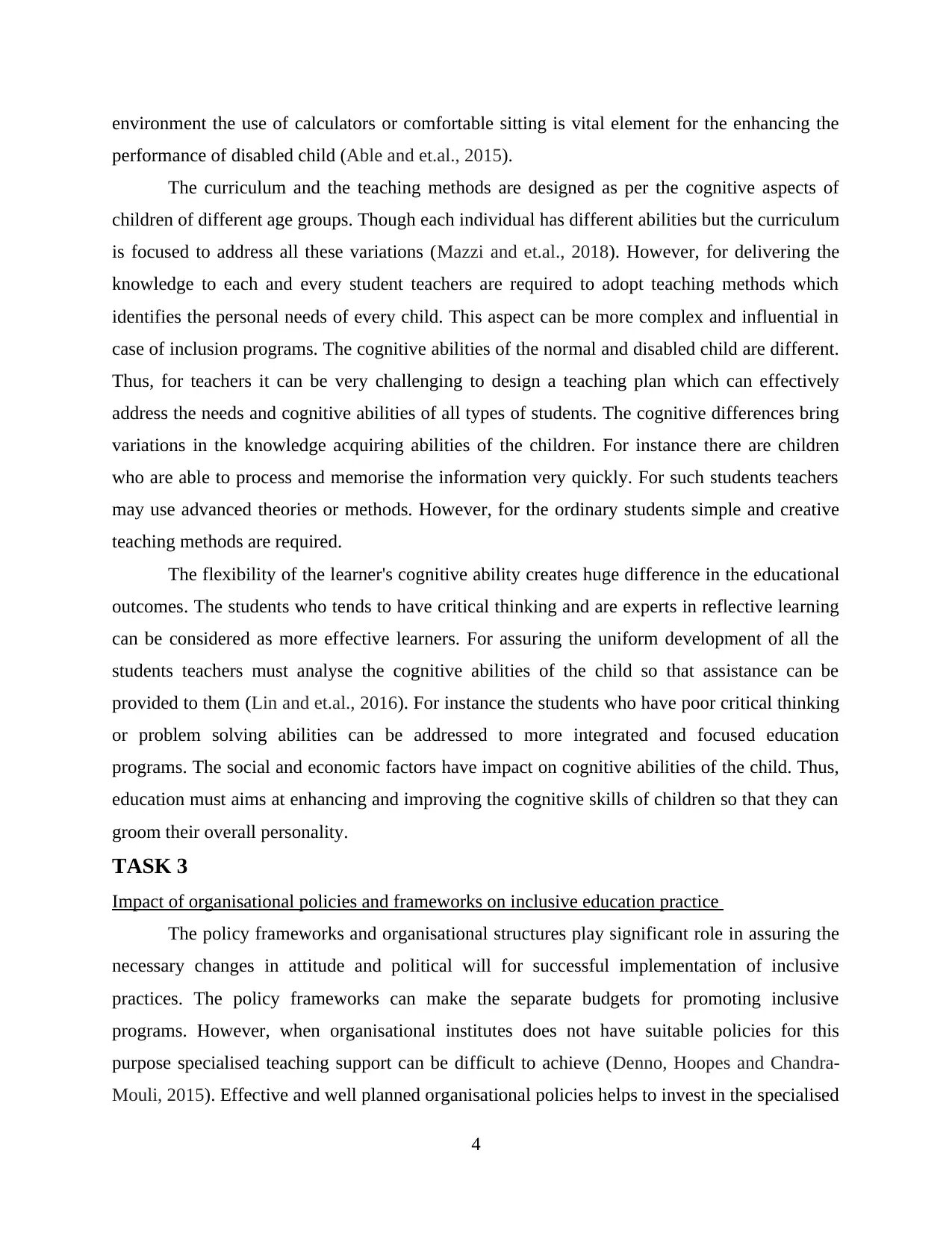
environment the use of calculators or comfortable sitting is vital element for the enhancing the
performance of disabled child (Able and et.al., 2015).
The curriculum and the teaching methods are designed as per the cognitive aspects of
children of different age groups. Though each individual has different abilities but the curriculum
is focused to address all these variations (Mazzi and et.al., 2018). However, for delivering the
knowledge to each and every student teachers are required to adopt teaching methods which
identifies the personal needs of every child. This aspect can be more complex and influential in
case of inclusion programs. The cognitive abilities of the normal and disabled child are different.
Thus, for teachers it can be very challenging to design a teaching plan which can effectively
address the needs and cognitive abilities of all types of students. The cognitive differences bring
variations in the knowledge acquiring abilities of the children. For instance there are children
who are able to process and memorise the information very quickly. For such students teachers
may use advanced theories or methods. However, for the ordinary students simple and creative
teaching methods are required.
The flexibility of the learner's cognitive ability creates huge difference in the educational
outcomes. The students who tends to have critical thinking and are experts in reflective learning
can be considered as more effective learners. For assuring the uniform development of all the
students teachers must analyse the cognitive abilities of the child so that assistance can be
provided to them (Lin and et.al., 2016). For instance the students who have poor critical thinking
or problem solving abilities can be addressed to more integrated and focused education
programs. The social and economic factors have impact on cognitive abilities of the child. Thus,
education must aims at enhancing and improving the cognitive skills of children so that they can
groom their overall personality.
TASK 3
Impact of organisational policies and frameworks on inclusive education practice
The policy frameworks and organisational structures play significant role in assuring the
necessary changes in attitude and political will for successful implementation of inclusive
practices. The policy frameworks can make the separate budgets for promoting inclusive
programs. However, when organisational institutes does not have suitable policies for this
purpose specialised teaching support can be difficult to achieve (Denno, Hoopes and Chandra-
Mouli, 2015). Effective and well planned organisational policies helps to invest in the specialised
4
performance of disabled child (Able and et.al., 2015).
The curriculum and the teaching methods are designed as per the cognitive aspects of
children of different age groups. Though each individual has different abilities but the curriculum
is focused to address all these variations (Mazzi and et.al., 2018). However, for delivering the
knowledge to each and every student teachers are required to adopt teaching methods which
identifies the personal needs of every child. This aspect can be more complex and influential in
case of inclusion programs. The cognitive abilities of the normal and disabled child are different.
Thus, for teachers it can be very challenging to design a teaching plan which can effectively
address the needs and cognitive abilities of all types of students. The cognitive differences bring
variations in the knowledge acquiring abilities of the children. For instance there are children
who are able to process and memorise the information very quickly. For such students teachers
may use advanced theories or methods. However, for the ordinary students simple and creative
teaching methods are required.
The flexibility of the learner's cognitive ability creates huge difference in the educational
outcomes. The students who tends to have critical thinking and are experts in reflective learning
can be considered as more effective learners. For assuring the uniform development of all the
students teachers must analyse the cognitive abilities of the child so that assistance can be
provided to them (Lin and et.al., 2016). For instance the students who have poor critical thinking
or problem solving abilities can be addressed to more integrated and focused education
programs. The social and economic factors have impact on cognitive abilities of the child. Thus,
education must aims at enhancing and improving the cognitive skills of children so that they can
groom their overall personality.
TASK 3
Impact of organisational policies and frameworks on inclusive education practice
The policy frameworks and organisational structures play significant role in assuring the
necessary changes in attitude and political will for successful implementation of inclusive
practices. The policy frameworks can make the separate budgets for promoting inclusive
programs. However, when organisational institutes does not have suitable policies for this
purpose specialised teaching support can be difficult to achieve (Denno, Hoopes and Chandra-
Mouli, 2015). Effective and well planned organisational policies helps to invest in the specialised
4
⊘ This is a preview!⊘
Do you want full access?
Subscribe today to unlock all pages.

Trusted by 1+ million students worldwide
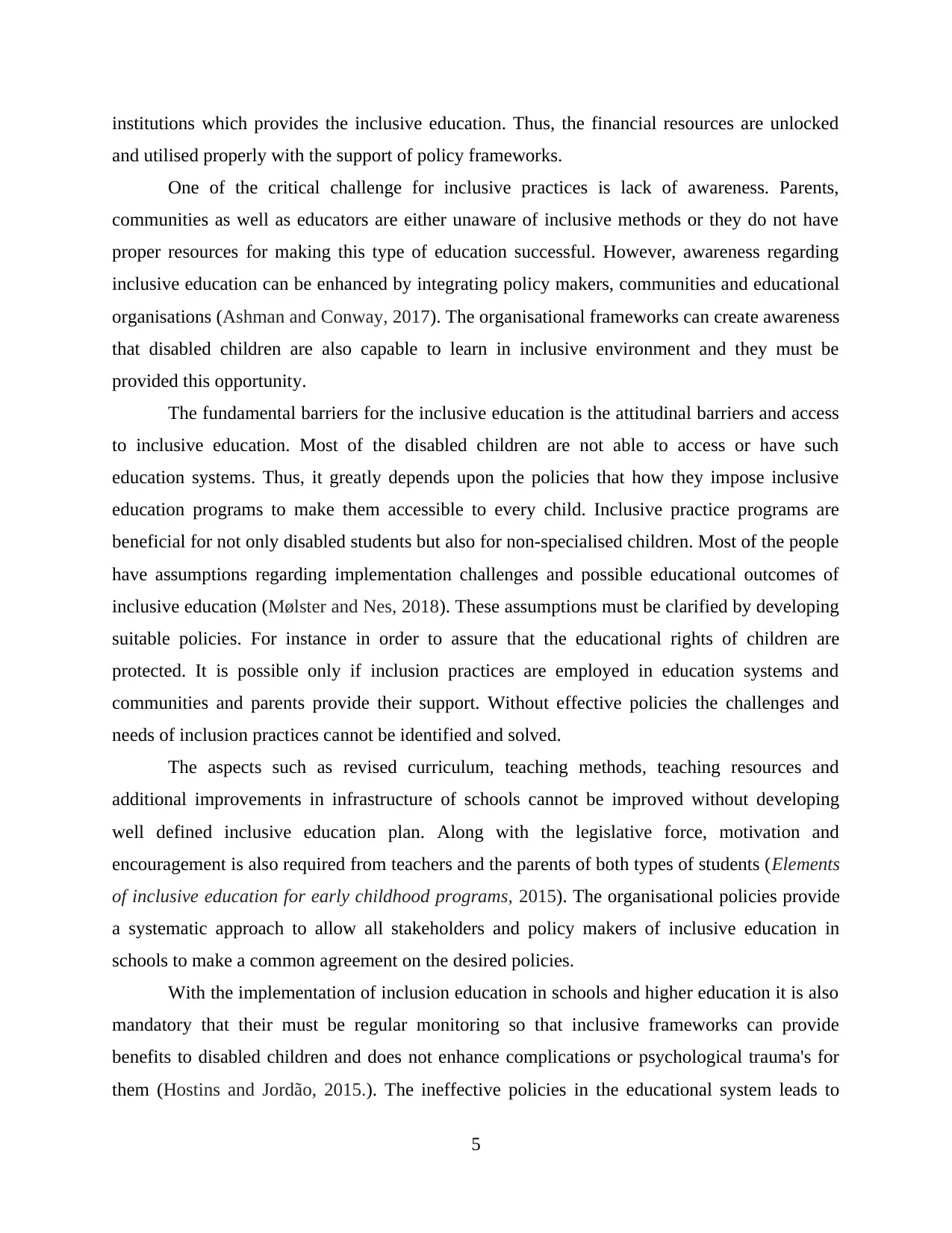
institutions which provides the inclusive education. Thus, the financial resources are unlocked
and utilised properly with the support of policy frameworks.
One of the critical challenge for inclusive practices is lack of awareness. Parents,
communities as well as educators are either unaware of inclusive methods or they do not have
proper resources for making this type of education successful. However, awareness regarding
inclusive education can be enhanced by integrating policy makers, communities and educational
organisations (Ashman and Conway, 2017). The organisational frameworks can create awareness
that disabled children are also capable to learn in inclusive environment and they must be
provided this opportunity.
The fundamental barriers for the inclusive education is the attitudinal barriers and access
to inclusive education. Most of the disabled children are not able to access or have such
education systems. Thus, it greatly depends upon the policies that how they impose inclusive
education programs to make them accessible to every child. Inclusive practice programs are
beneficial for not only disabled students but also for non-specialised children. Most of the people
have assumptions regarding implementation challenges and possible educational outcomes of
inclusive education (Mølster and Nes, 2018). These assumptions must be clarified by developing
suitable policies. For instance in order to assure that the educational rights of children are
protected. It is possible only if inclusion practices are employed in education systems and
communities and parents provide their support. Without effective policies the challenges and
needs of inclusion practices cannot be identified and solved.
The aspects such as revised curriculum, teaching methods, teaching resources and
additional improvements in infrastructure of schools cannot be improved without developing
well defined inclusive education plan. Along with the legislative force, motivation and
encouragement is also required from teachers and the parents of both types of students (Elements
of inclusive education for early childhood programs, 2015). The organisational policies provide
a systematic approach to allow all stakeholders and policy makers of inclusive education in
schools to make a common agreement on the desired policies.
With the implementation of inclusion education in schools and higher education it is also
mandatory that their must be regular monitoring so that inclusive frameworks can provide
benefits to disabled children and does not enhance complications or psychological trauma's for
them (Hostins and Jordão, 2015.). The ineffective policies in the educational system leads to
5
and utilised properly with the support of policy frameworks.
One of the critical challenge for inclusive practices is lack of awareness. Parents,
communities as well as educators are either unaware of inclusive methods or they do not have
proper resources for making this type of education successful. However, awareness regarding
inclusive education can be enhanced by integrating policy makers, communities and educational
organisations (Ashman and Conway, 2017). The organisational frameworks can create awareness
that disabled children are also capable to learn in inclusive environment and they must be
provided this opportunity.
The fundamental barriers for the inclusive education is the attitudinal barriers and access
to inclusive education. Most of the disabled children are not able to access or have such
education systems. Thus, it greatly depends upon the policies that how they impose inclusive
education programs to make them accessible to every child. Inclusive practice programs are
beneficial for not only disabled students but also for non-specialised children. Most of the people
have assumptions regarding implementation challenges and possible educational outcomes of
inclusive education (Mølster and Nes, 2018). These assumptions must be clarified by developing
suitable policies. For instance in order to assure that the educational rights of children are
protected. It is possible only if inclusion practices are employed in education systems and
communities and parents provide their support. Without effective policies the challenges and
needs of inclusion practices cannot be identified and solved.
The aspects such as revised curriculum, teaching methods, teaching resources and
additional improvements in infrastructure of schools cannot be improved without developing
well defined inclusive education plan. Along with the legislative force, motivation and
encouragement is also required from teachers and the parents of both types of students (Elements
of inclusive education for early childhood programs, 2015). The organisational policies provide
a systematic approach to allow all stakeholders and policy makers of inclusive education in
schools to make a common agreement on the desired policies.
With the implementation of inclusion education in schools and higher education it is also
mandatory that their must be regular monitoring so that inclusive frameworks can provide
benefits to disabled children and does not enhance complications or psychological trauma's for
them (Hostins and Jordão, 2015.). The ineffective policies in the educational system leads to
5
Paraphrase This Document
Need a fresh take? Get an instant paraphrase of this document with our AI Paraphraser
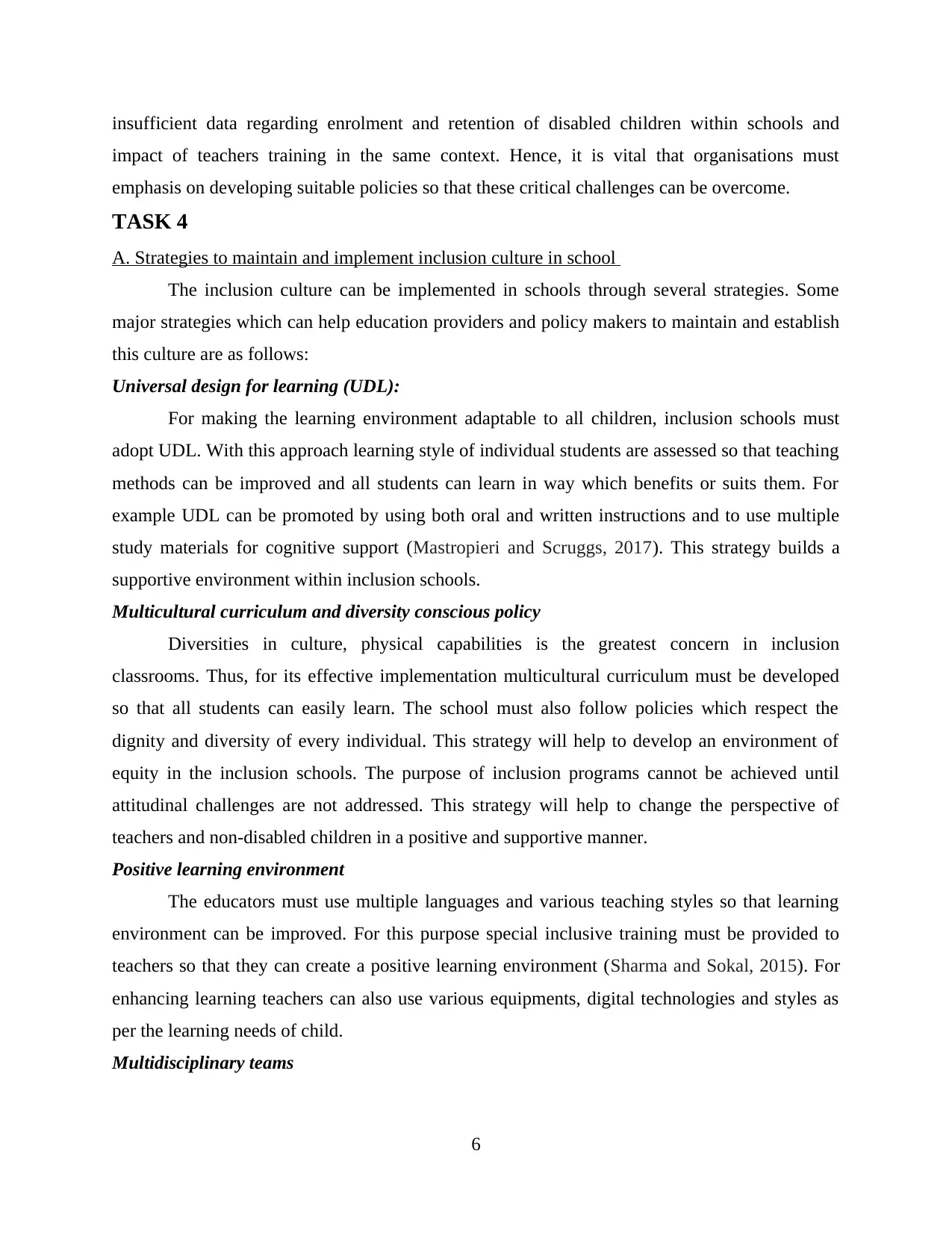
insufficient data regarding enrolment and retention of disabled children within schools and
impact of teachers training in the same context. Hence, it is vital that organisations must
emphasis on developing suitable policies so that these critical challenges can be overcome.
TASK 4
A. Strategies to maintain and implement inclusion culture in school
The inclusion culture can be implemented in schools through several strategies. Some
major strategies which can help education providers and policy makers to maintain and establish
this culture are as follows:
Universal design for learning (UDL):
For making the learning environment adaptable to all children, inclusion schools must
adopt UDL. With this approach learning style of individual students are assessed so that teaching
methods can be improved and all students can learn in way which benefits or suits them. For
example UDL can be promoted by using both oral and written instructions and to use multiple
study materials for cognitive support (Mastropieri and Scruggs, 2017). This strategy builds a
supportive environment within inclusion schools.
Multicultural curriculum and diversity conscious policy
Diversities in culture, physical capabilities is the greatest concern in inclusion
classrooms. Thus, for its effective implementation multicultural curriculum must be developed
so that all students can easily learn. The school must also follow policies which respect the
dignity and diversity of every individual. This strategy will help to develop an environment of
equity in the inclusion schools. The purpose of inclusion programs cannot be achieved until
attitudinal challenges are not addressed. This strategy will help to change the perspective of
teachers and non-disabled children in a positive and supportive manner.
Positive learning environment
The educators must use multiple languages and various teaching styles so that learning
environment can be improved. For this purpose special inclusive training must be provided to
teachers so that they can create a positive learning environment (Sharma and Sokal, 2015). For
enhancing learning teachers can also use various equipments, digital technologies and styles as
per the learning needs of child.
Multidisciplinary teams
6
impact of teachers training in the same context. Hence, it is vital that organisations must
emphasis on developing suitable policies so that these critical challenges can be overcome.
TASK 4
A. Strategies to maintain and implement inclusion culture in school
The inclusion culture can be implemented in schools through several strategies. Some
major strategies which can help education providers and policy makers to maintain and establish
this culture are as follows:
Universal design for learning (UDL):
For making the learning environment adaptable to all children, inclusion schools must
adopt UDL. With this approach learning style of individual students are assessed so that teaching
methods can be improved and all students can learn in way which benefits or suits them. For
example UDL can be promoted by using both oral and written instructions and to use multiple
study materials for cognitive support (Mastropieri and Scruggs, 2017). This strategy builds a
supportive environment within inclusion schools.
Multicultural curriculum and diversity conscious policy
Diversities in culture, physical capabilities is the greatest concern in inclusion
classrooms. Thus, for its effective implementation multicultural curriculum must be developed
so that all students can easily learn. The school must also follow policies which respect the
dignity and diversity of every individual. This strategy will help to develop an environment of
equity in the inclusion schools. The purpose of inclusion programs cannot be achieved until
attitudinal challenges are not addressed. This strategy will help to change the perspective of
teachers and non-disabled children in a positive and supportive manner.
Positive learning environment
The educators must use multiple languages and various teaching styles so that learning
environment can be improved. For this purpose special inclusive training must be provided to
teachers so that they can create a positive learning environment (Sharma and Sokal, 2015). For
enhancing learning teachers can also use various equipments, digital technologies and styles as
per the learning needs of child.
Multidisciplinary teams
6
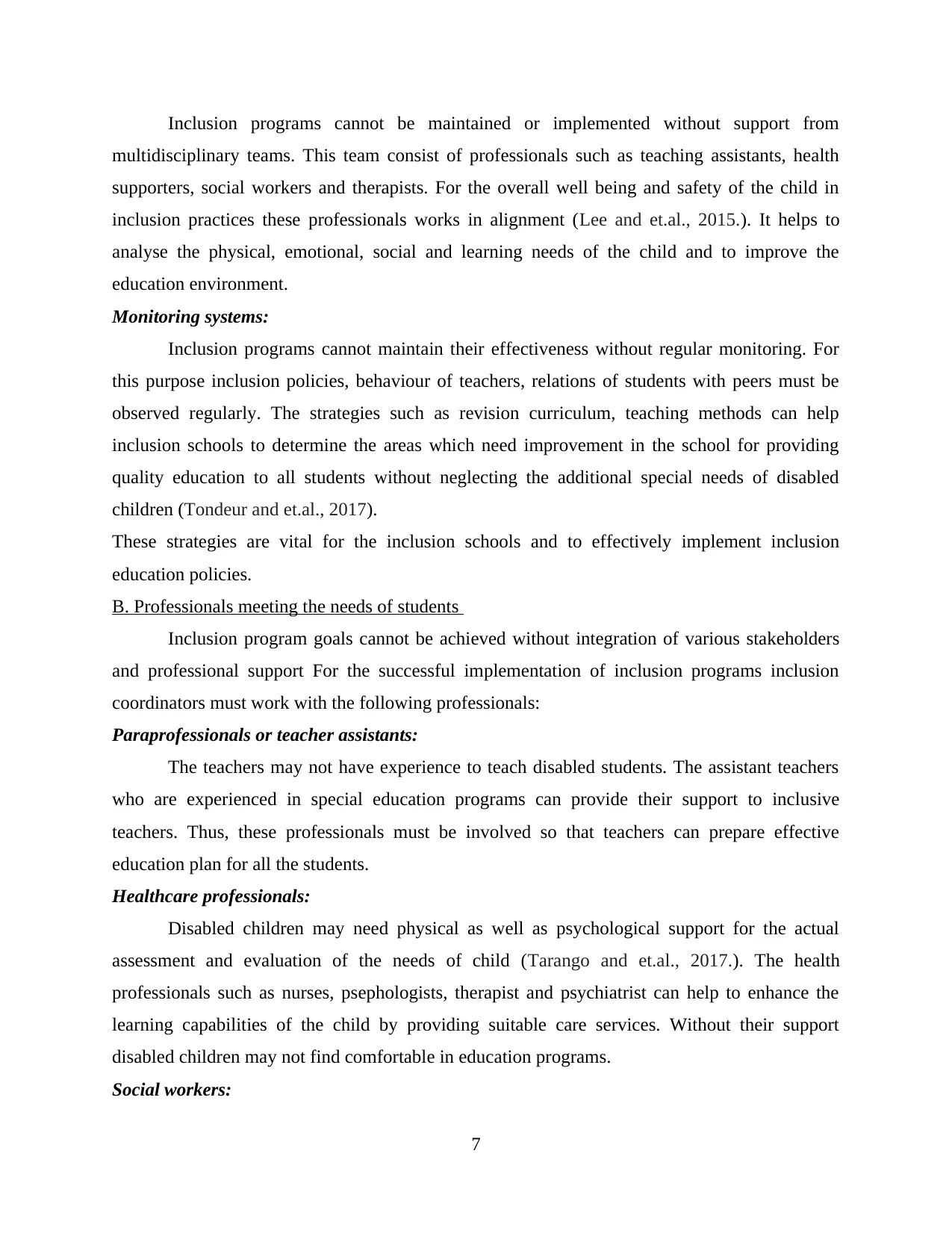
Inclusion programs cannot be maintained or implemented without support from
multidisciplinary teams. This team consist of professionals such as teaching assistants, health
supporters, social workers and therapists. For the overall well being and safety of the child in
inclusion practices these professionals works in alignment (Lee and et.al., 2015.). It helps to
analyse the physical, emotional, social and learning needs of the child and to improve the
education environment.
Monitoring systems:
Inclusion programs cannot maintain their effectiveness without regular monitoring. For
this purpose inclusion policies, behaviour of teachers, relations of students with peers must be
observed regularly. The strategies such as revision curriculum, teaching methods can help
inclusion schools to determine the areas which need improvement in the school for providing
quality education to all students without neglecting the additional special needs of disabled
children (Tondeur and et.al., 2017).
These strategies are vital for the inclusion schools and to effectively implement inclusion
education policies.
B. Professionals meeting the needs of students
Inclusion program goals cannot be achieved without integration of various stakeholders
and professional support For the successful implementation of inclusion programs inclusion
coordinators must work with the following professionals:
Paraprofessionals or teacher assistants:
The teachers may not have experience to teach disabled students. The assistant teachers
who are experienced in special education programs can provide their support to inclusive
teachers. Thus, these professionals must be involved so that teachers can prepare effective
education plan for all the students.
Healthcare professionals:
Disabled children may need physical as well as psychological support for the actual
assessment and evaluation of the needs of child (Tarango and et.al., 2017.). The health
professionals such as nurses, psephologists, therapist and psychiatrist can help to enhance the
learning capabilities of the child by providing suitable care services. Without their support
disabled children may not find comfortable in education programs.
Social workers:
7
multidisciplinary teams. This team consist of professionals such as teaching assistants, health
supporters, social workers and therapists. For the overall well being and safety of the child in
inclusion practices these professionals works in alignment (Lee and et.al., 2015.). It helps to
analyse the physical, emotional, social and learning needs of the child and to improve the
education environment.
Monitoring systems:
Inclusion programs cannot maintain their effectiveness without regular monitoring. For
this purpose inclusion policies, behaviour of teachers, relations of students with peers must be
observed regularly. The strategies such as revision curriculum, teaching methods can help
inclusion schools to determine the areas which need improvement in the school for providing
quality education to all students without neglecting the additional special needs of disabled
children (Tondeur and et.al., 2017).
These strategies are vital for the inclusion schools and to effectively implement inclusion
education policies.
B. Professionals meeting the needs of students
Inclusion program goals cannot be achieved without integration of various stakeholders
and professional support For the successful implementation of inclusion programs inclusion
coordinators must work with the following professionals:
Paraprofessionals or teacher assistants:
The teachers may not have experience to teach disabled students. The assistant teachers
who are experienced in special education programs can provide their support to inclusive
teachers. Thus, these professionals must be involved so that teachers can prepare effective
education plan for all the students.
Healthcare professionals:
Disabled children may need physical as well as psychological support for the actual
assessment and evaluation of the needs of child (Tarango and et.al., 2017.). The health
professionals such as nurses, psephologists, therapist and psychiatrist can help to enhance the
learning capabilities of the child by providing suitable care services. Without their support
disabled children may not find comfortable in education programs.
Social workers:
7
⊘ This is a preview!⊘
Do you want full access?
Subscribe today to unlock all pages.

Trusted by 1+ million students worldwide
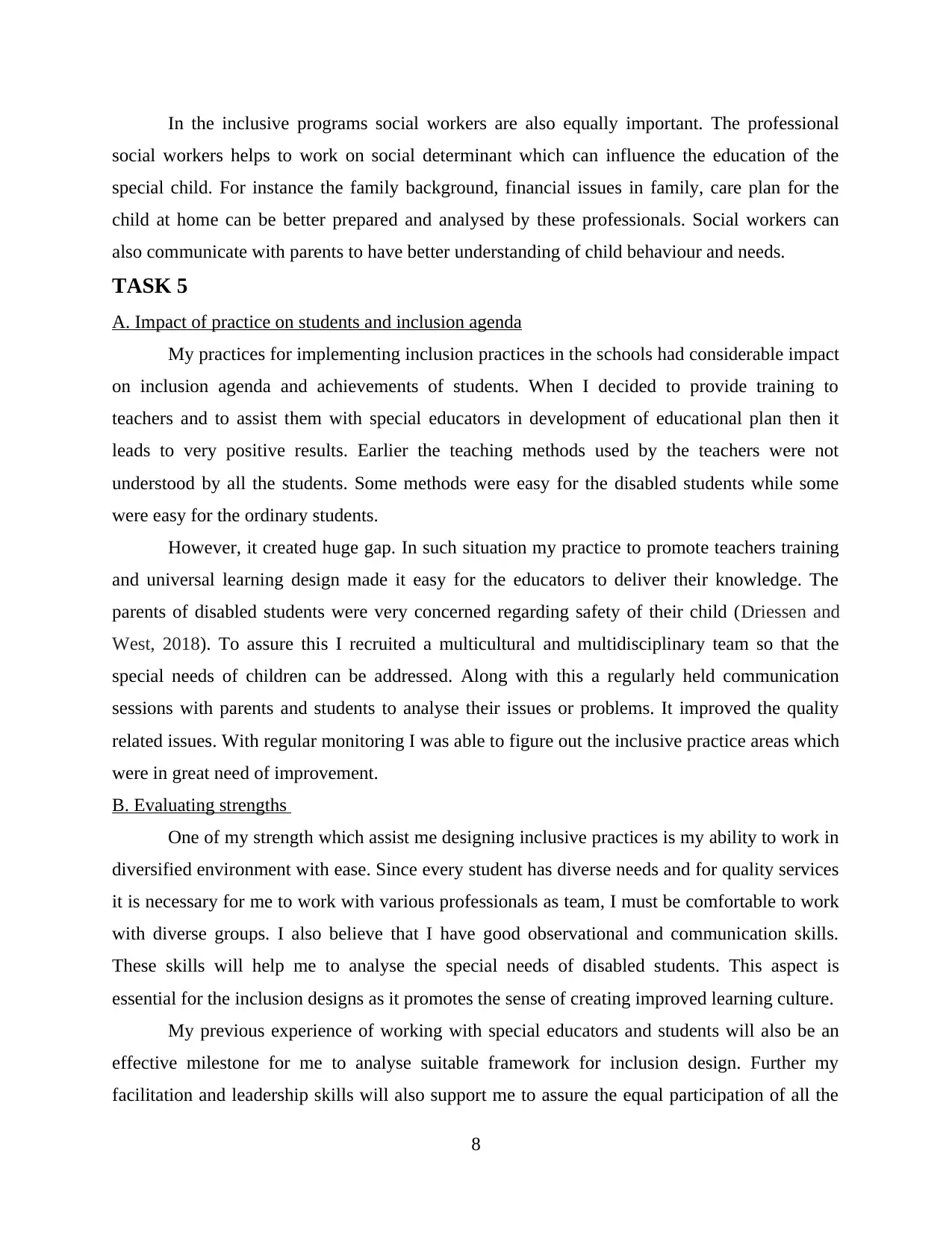
In the inclusive programs social workers are also equally important. The professional
social workers helps to work on social determinant which can influence the education of the
special child. For instance the family background, financial issues in family, care plan for the
child at home can be better prepared and analysed by these professionals. Social workers can
also communicate with parents to have better understanding of child behaviour and needs.
TASK 5
A. Impact of practice on students and inclusion agenda
My practices for implementing inclusion practices in the schools had considerable impact
on inclusion agenda and achievements of students. When I decided to provide training to
teachers and to assist them with special educators in development of educational plan then it
leads to very positive results. Earlier the teaching methods used by the teachers were not
understood by all the students. Some methods were easy for the disabled students while some
were easy for the ordinary students.
However, it created huge gap. In such situation my practice to promote teachers training
and universal learning design made it easy for the educators to deliver their knowledge. The
parents of disabled students were very concerned regarding safety of their child (Driessen and
West, 2018). To assure this I recruited a multicultural and multidisciplinary team so that the
special needs of children can be addressed. Along with this a regularly held communication
sessions with parents and students to analyse their issues or problems. It improved the quality
related issues. With regular monitoring I was able to figure out the inclusive practice areas which
were in great need of improvement.
B. Evaluating strengths
One of my strength which assist me designing inclusive practices is my ability to work in
diversified environment with ease. Since every student has diverse needs and for quality services
it is necessary for me to work with various professionals as team, I must be comfortable to work
with diverse groups. I also believe that I have good observational and communication skills.
These skills will help me to analyse the special needs of disabled students. This aspect is
essential for the inclusion designs as it promotes the sense of creating improved learning culture.
My previous experience of working with special educators and students will also be an
effective milestone for me to analyse suitable framework for inclusion design. Further my
facilitation and leadership skills will also support me to assure the equal participation of all the
8
social workers helps to work on social determinant which can influence the education of the
special child. For instance the family background, financial issues in family, care plan for the
child at home can be better prepared and analysed by these professionals. Social workers can
also communicate with parents to have better understanding of child behaviour and needs.
TASK 5
A. Impact of practice on students and inclusion agenda
My practices for implementing inclusion practices in the schools had considerable impact
on inclusion agenda and achievements of students. When I decided to provide training to
teachers and to assist them with special educators in development of educational plan then it
leads to very positive results. Earlier the teaching methods used by the teachers were not
understood by all the students. Some methods were easy for the disabled students while some
were easy for the ordinary students.
However, it created huge gap. In such situation my practice to promote teachers training
and universal learning design made it easy for the educators to deliver their knowledge. The
parents of disabled students were very concerned regarding safety of their child (Driessen and
West, 2018). To assure this I recruited a multicultural and multidisciplinary team so that the
special needs of children can be addressed. Along with this a regularly held communication
sessions with parents and students to analyse their issues or problems. It improved the quality
related issues. With regular monitoring I was able to figure out the inclusive practice areas which
were in great need of improvement.
B. Evaluating strengths
One of my strength which assist me designing inclusive practices is my ability to work in
diversified environment with ease. Since every student has diverse needs and for quality services
it is necessary for me to work with various professionals as team, I must be comfortable to work
with diverse groups. I also believe that I have good observational and communication skills.
These skills will help me to analyse the special needs of disabled students. This aspect is
essential for the inclusion designs as it promotes the sense of creating improved learning culture.
My previous experience of working with special educators and students will also be an
effective milestone for me to analyse suitable framework for inclusion design. Further my
facilitation and leadership skills will also support me to assure the equal participation of all the
8
Paraphrase This Document
Need a fresh take? Get an instant paraphrase of this document with our AI Paraphraser
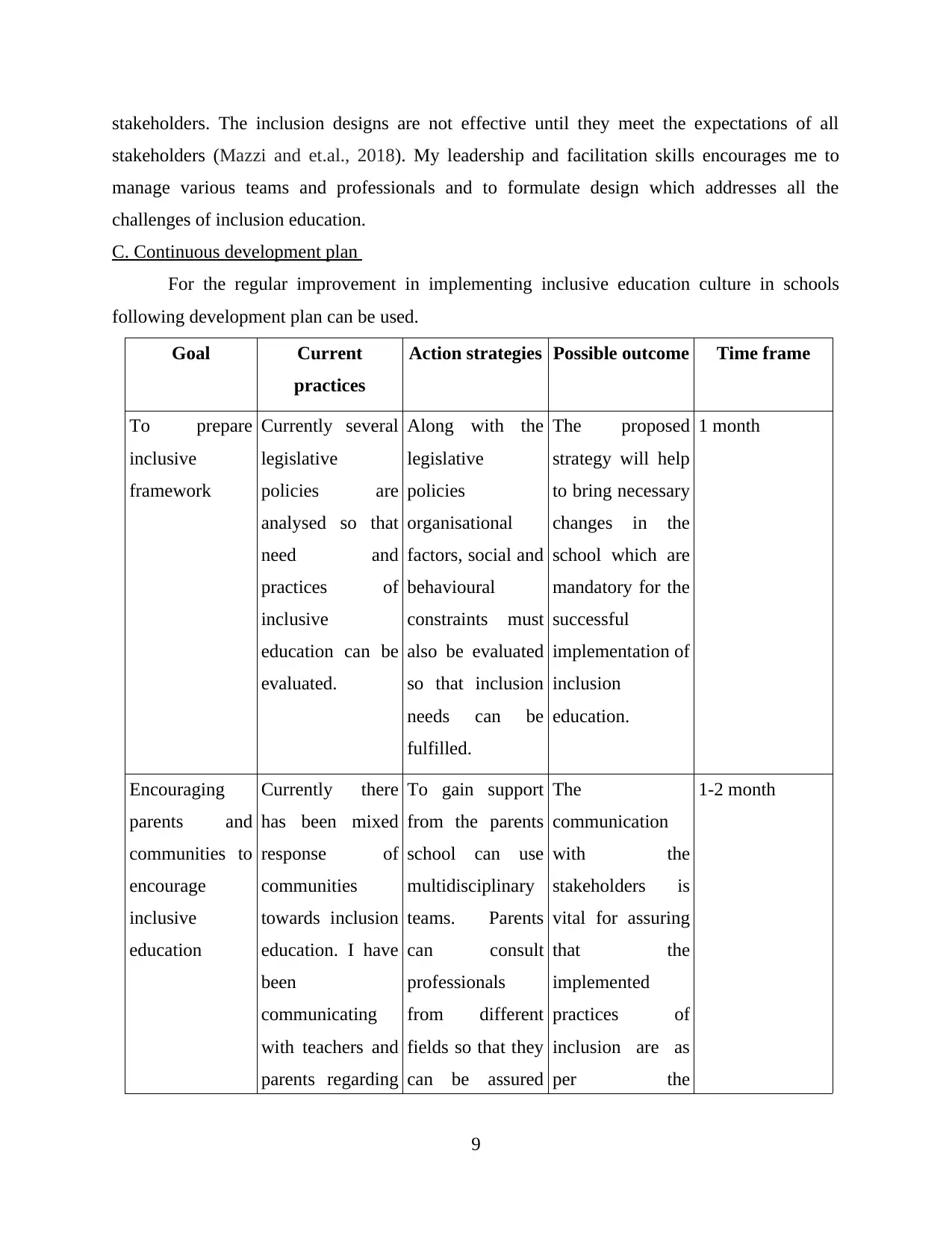
stakeholders. The inclusion designs are not effective until they meet the expectations of all
stakeholders (Mazzi and et.al., 2018). My leadership and facilitation skills encourages me to
manage various teams and professionals and to formulate design which addresses all the
challenges of inclusion education.
C. Continuous development plan
For the regular improvement in implementing inclusive education culture in schools
following development plan can be used.
Goal Current
practices
Action strategies Possible outcome Time frame
To prepare
inclusive
framework
Currently several
legislative
policies are
analysed so that
need and
practices of
inclusive
education can be
evaluated.
Along with the
legislative
policies
organisational
factors, social and
behavioural
constraints must
also be evaluated
so that inclusion
needs can be
fulfilled.
The proposed
strategy will help
to bring necessary
changes in the
school which are
mandatory for the
successful
implementation of
inclusion
education.
1 month
Encouraging
parents and
communities to
encourage
inclusive
education
Currently there
has been mixed
response of
communities
towards inclusion
education. I have
been
communicating
with teachers and
parents regarding
To gain support
from the parents
school can use
multidisciplinary
teams. Parents
can consult
professionals
from different
fields so that they
can be assured
The
communication
with the
stakeholders is
vital for assuring
that the
implemented
practices of
inclusion are as
per the
1-2 month
9
stakeholders (Mazzi and et.al., 2018). My leadership and facilitation skills encourages me to
manage various teams and professionals and to formulate design which addresses all the
challenges of inclusion education.
C. Continuous development plan
For the regular improvement in implementing inclusive education culture in schools
following development plan can be used.
Goal Current
practices
Action strategies Possible outcome Time frame
To prepare
inclusive
framework
Currently several
legislative
policies are
analysed so that
need and
practices of
inclusive
education can be
evaluated.
Along with the
legislative
policies
organisational
factors, social and
behavioural
constraints must
also be evaluated
so that inclusion
needs can be
fulfilled.
The proposed
strategy will help
to bring necessary
changes in the
school which are
mandatory for the
successful
implementation of
inclusion
education.
1 month
Encouraging
parents and
communities to
encourage
inclusive
education
Currently there
has been mixed
response of
communities
towards inclusion
education. I have
been
communicating
with teachers and
parents regarding
To gain support
from the parents
school can use
multidisciplinary
teams. Parents
can consult
professionals
from different
fields so that they
can be assured
The
communication
with the
stakeholders is
vital for assuring
that the
implemented
practices of
inclusion are as
per the
1-2 month
9
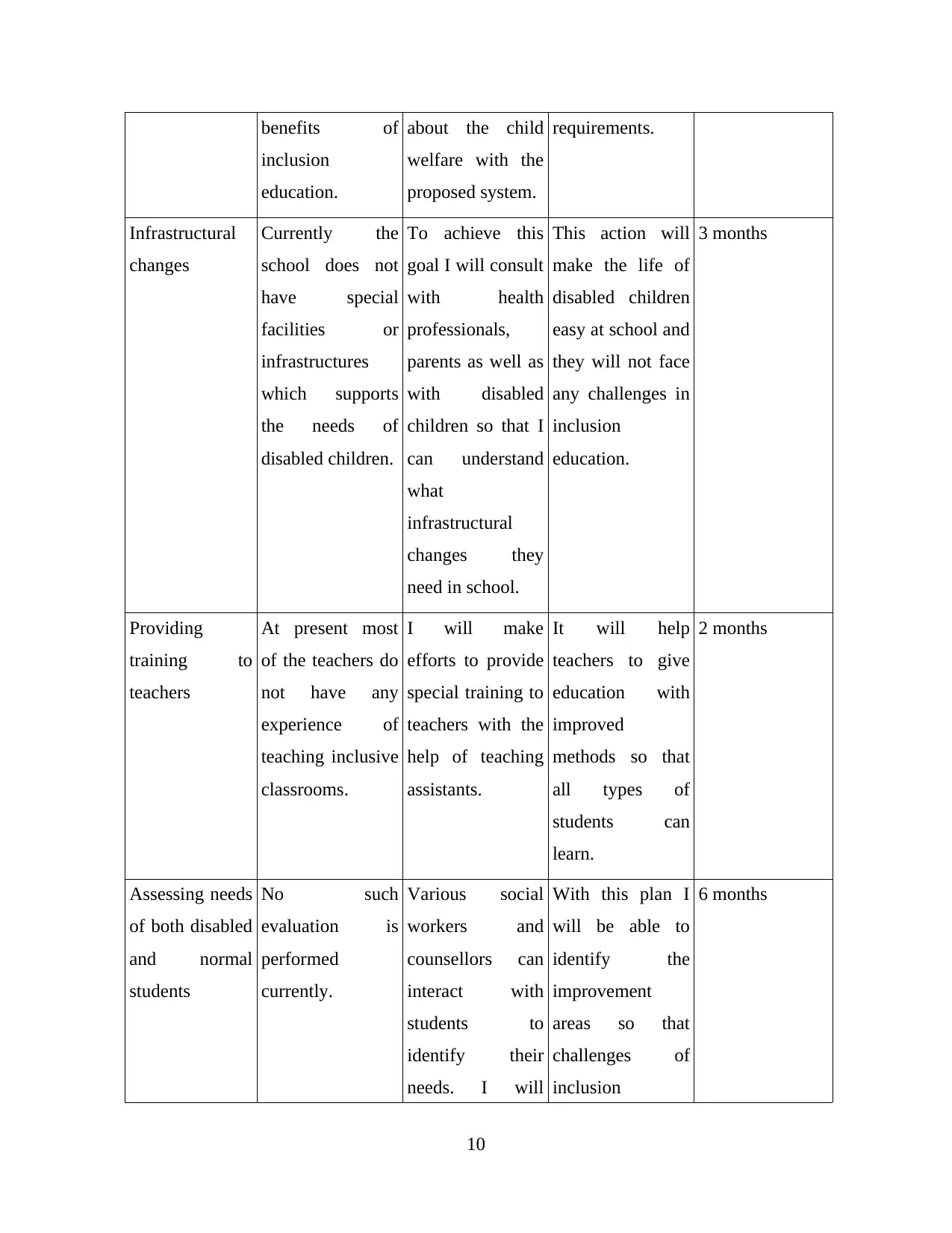
benefits of
inclusion
education.
about the child
welfare with the
proposed system.
requirements.
Infrastructural
changes
Currently the
school does not
have special
facilities or
infrastructures
which supports
the needs of
disabled children.
To achieve this
goal I will consult
with health
professionals,
parents as well as
with disabled
children so that I
can understand
what
infrastructural
changes they
need in school.
This action will
make the life of
disabled children
easy at school and
they will not face
any challenges in
inclusion
education.
3 months
Providing
training to
teachers
At present most
of the teachers do
not have any
experience of
teaching inclusive
classrooms.
I will make
efforts to provide
special training to
teachers with the
help of teaching
assistants.
It will help
teachers to give
education with
improved
methods so that
all types of
students can
learn.
2 months
Assessing needs
of both disabled
and normal
students
No such
evaluation is
performed
currently.
Various social
workers and
counsellors can
interact with
students to
identify their
needs. I will
With this plan I
will be able to
identify the
improvement
areas so that
challenges of
inclusion
6 months
10
inclusion
education.
about the child
welfare with the
proposed system.
requirements.
Infrastructural
changes
Currently the
school does not
have special
facilities or
infrastructures
which supports
the needs of
disabled children.
To achieve this
goal I will consult
with health
professionals,
parents as well as
with disabled
children so that I
can understand
what
infrastructural
changes they
need in school.
This action will
make the life of
disabled children
easy at school and
they will not face
any challenges in
inclusion
education.
3 months
Providing
training to
teachers
At present most
of the teachers do
not have any
experience of
teaching inclusive
classrooms.
I will make
efforts to provide
special training to
teachers with the
help of teaching
assistants.
It will help
teachers to give
education with
improved
methods so that
all types of
students can
learn.
2 months
Assessing needs
of both disabled
and normal
students
No such
evaluation is
performed
currently.
Various social
workers and
counsellors can
interact with
students to
identify their
needs. I will
With this plan I
will be able to
identify the
improvement
areas so that
challenges of
inclusion
6 months
10
⊘ This is a preview!⊘
Do you want full access?
Subscribe today to unlock all pages.

Trusted by 1+ million students worldwide
1 out of 20
Related Documents
Your All-in-One AI-Powered Toolkit for Academic Success.
+13062052269
info@desklib.com
Available 24*7 on WhatsApp / Email
![[object Object]](/_next/static/media/star-bottom.7253800d.svg)
Unlock your academic potential
Copyright © 2020–2025 A2Z Services. All Rights Reserved. Developed and managed by ZUCOL.



